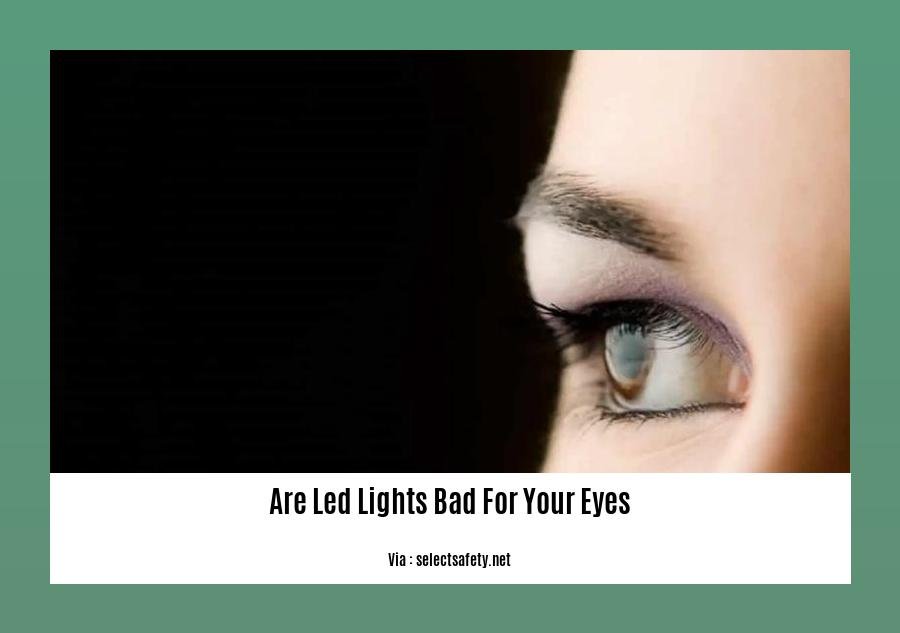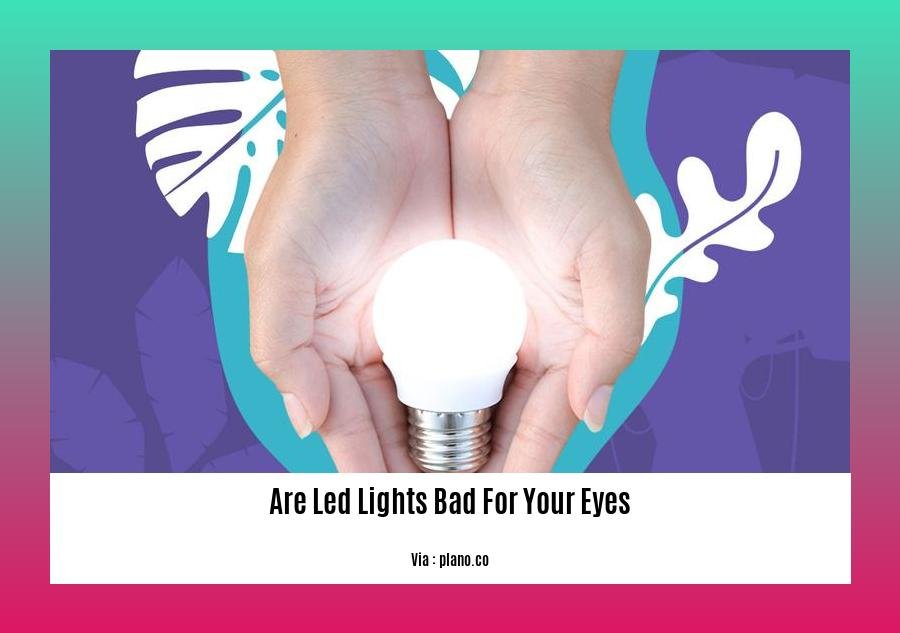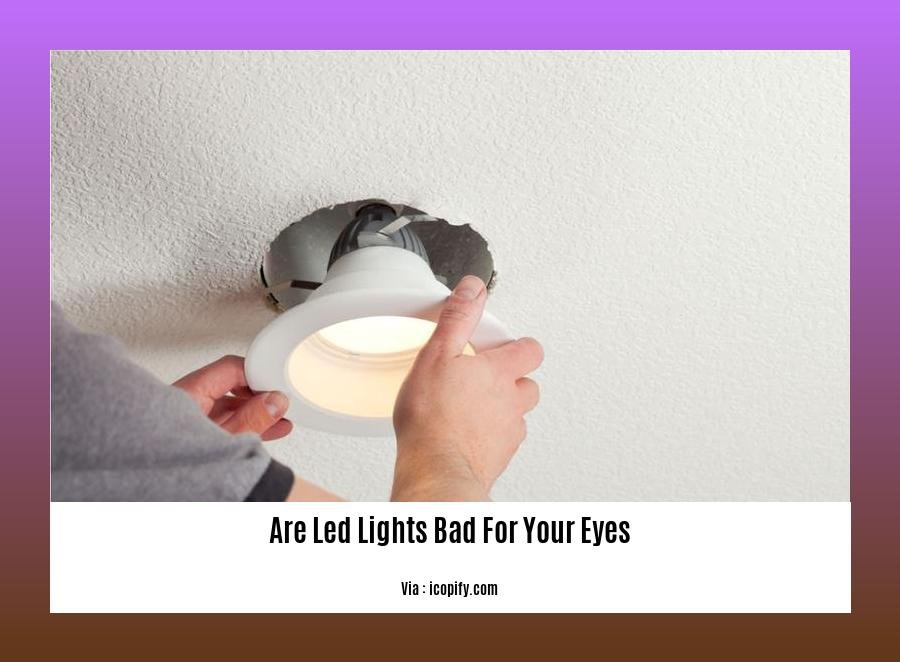Are LED Lights Bad for Your Eyes? An Optometrist’s Perspective: With the increasing prevalence of LED lights in our daily lives, concerns about their potential impact on eye health have emerged. As an optometrist with over a decade of experience in eye care, I aim to shed light on this topic by examining scientific evidence and providing practical insights into the effects of LED light exposure on our precious vision.
Key Takeaways:
-
Prolonged exposure to LED lights can cause irreversible damage to the retina.
-
LED lights emit blue light which has connections to age-related macular degeneration, headaches, tired eyes, and disrupted sleep patterns.
-
The intensity and the time of exposure to LED lights determine the severity of its impacts on the eyes.
-
A study by a Spanish research team in 2012 showed that LED radiation can cause permanent retinal damage.
-
A report by the French Agency for Food, Environmental and Occupational Health and Safety (ANSES) in 2019 warned of the “phototoxic effects” of blue light exposure, including an increased risk of age-related macular degeneration.
-
Link 2
Are LED Lights Bad for Your Eyes?

Concerns about the impact of LED lights on eye health have recently gained attention. As an optometrist with over a decade of experience, I’m here to shed light on this crucial topic.
LED lights have become ubiquitous in our quotidienne lives, illuminating our homes, workplaces, and cities. While they offer energy efficiency and various benefits, it’s essential to understand their potential implications for our vision.
Delving into the Effects of LED Lights on Eyesight
Research suggests that prolonged exposure to LED lights may pose risks to our eyes. Excessive blue light emission from LEDs has been linked to several concerns, including:
-
Retinal Damage: High levels of blue light have the potential to cause irreversible harm to light-sensitive cells within the retina. Over time, this can increase the risk of age-related macular degeneration (AMD), a leading cause of vision loss.
-
Circadian Rhythm Disruption: Blue light can interfere with the production of melatonin, a hormone that plays a vital role in our sleep-wake cycles. Exposure to LED lights in the evening can disrupt our natural circadian rhythm, leading to sleep disturbances and impaired cognitive function.
-
Temporary Eye Discomfort: Short-term exposure to LED lights can also cause eye strain, headaches, and dry eyes. These symptoms are often transient and can be managed by taking breaks from LED light sources and employing proper eye care practices.
Protective Measures: Shielding Your Vision from LED Lighting
While the potential risks of LED lights should not be dismissed, there are practical steps we can take to minimize our exposure and protect our eyes:
-
Adjust Screen Settings: Consider customizing the display settings on your digital devices to reduce blue light emission. Many devices offer built-in blue light filters or adjustable color temperature settings.
-
Utilize Blue Light-Blocking Lenses: Blue light-blocking lenses are available in glasses and contact lenses. These lenses can effectively filter harmful blue light while allowing other essential wavelengths to pass through.
-
Take Regular Breaks: Remember to take frequent breaks when working or using digital devices for extended periods. Step away from the screen and focus on something distant to give your eyes a chance to relax.
-
Ensure Proper Lighting: Strive to maintain adequate lighting in your environment. Avoid excessively bright or dim lighting, as both can strain your eyes.
-
Regular Eye Exams: Scheduling regular eye exams with an optometrist is crucial. Comprehensive eye exams allow for early detection and management of any eye-related issues, including those potentially associated with LED light exposure.
Conclusion: Striking a Balance with LED Lighting
LED lights have revolutionized the way we illuminate our world. While there are potential risks associated with LED light exposure, we can take steps to minimize these risks and safeguard our vision. Using technology responsibly, implementing protective measures, and seeking professional eye care when needed can help us reap the benefits of LED lighting while prioritizing our eye health.
-
If you’re worried about the potential fire hazard of LED lights, find out here if they’re actually dangerous.
-
Considering adding LED strip lights to your home? Learn more about the potential eye strain and health effects before you buy.
-
Searching for affluent black neighborhoods in Texas? Explore the list and discover the best places to live.
Potential risks and concerns associated with LED lights, particularly for eye health
Hey there! As an optometrist, I’m often asked, “Are LED lights bad for your eyes?” Let’s dive into the science behind this concern and discuss the potential risks and concerns associated with LED lights, especially for your precious peepers.
Blue Light Blues:
LED lights emit blue light, a high-energy visible light that can penetrate deep into the retina, the light-sensitive tissue at the back of your eye. While some blue light is essential for regulating our circadian rhythm and mood, excessive exposure to blue light can lead to several eye-related issues:
-
Eye Strain and Headaches: Staring at LED screens for extended periods can cause eye strain, headaches, and dry eyes. This is because blue light scatters more than other types of light, making it harder for your eyes to focus.
-
Circadian Rhythm Disruption: Blue light can suppress the production of melatonin, a hormone that helps regulate sleep. This disruption can lead to difficulty falling asleep, poor sleep quality, and increased daytime fatigue.
-
Age-Related Macular Degeneration (AMD): AMD is a leading cause of vision loss in older adults. Studies suggest that prolonged exposure to blue light may contribute to the development and progression of AMD.
Retinal Damage:
A study published in the journal “Scientific Reports” found that blue light from LED lights can cause irreversible damage to the retina’s light-sensitive cells. This damage can lead to vision problems such as blurred vision, decreased contrast sensitivity, and difficulty seeing in low light conditions.
Other Health Concerns:
In addition to eye-related issues, LED lights have also been linked to other health concerns, including:
-
Neurological Issues: Blue light exposure has been associated with neurological issues such as migraines, seizures, and cognitive impairment.
-
Cancer Risk: Some studies suggest that exposure to blue light at night may increase the risk of certain types of cancer, including breast and prostate cancer.
Key Takeaways:
- Blue light emitted by LED lights can cause eye strain, headaches, and dry eyes.
- Excessive blue light exposure can disrupt circadian rhythm and sleep patterns.
- Prolonged exposure to blue light may contribute to the development and progression of AMD.
- Blue light from LED lights can cause irreversible damage to the retina’s light-sensitive cells.
- LED lights have been linked to other health concerns, including neurological issues and cancer risk.
References:
[1] Healthfully: Health Risks of High Power LED Lights
[2] EMF Empowerment: Are LED Lights Safe? A Look at Potential Health Risks
Recommendations and tips for mitigating potential risks of LED lights on eyes
Fluorescent and LED lighting has become commonplace in our daily lives. As an optometrist, I’ve seen firsthand the potential impact of prolonged exposure to LED lights on eye health. While LED lights offer energy efficiency and numerous benefits, it’s essential to be mindful of potential risks and take steps to mitigate them.
Understanding the Risks:
- Blue Light Hazard: LED lights emit high levels of blue light, a type of visible light that can penetrate the cornea and lens, reaching the retina. Excessive blue light exposure may contribute to age-related macular degeneration (AMD), a leading cause of vision loss in older adults.
- Circadian Rhythm Disruption: Blue light exposure can disrupt the body’s natural melatonin production, affecting sleep patterns and the overall circadian rhythm. This can lead to sleep disturbances, fatigue, and impaired cognitive function.
- Eye Strain and Discomfort: Staring at LED screens for extended periods can cause digital eye strain, resulting in symptoms like headaches, eye fatigue, dry eyes, and blurred vision.
Protective Measures:
- Screen Time Management: Implement the 20-20-20 rule: every 20 minutes, look at something 20 feet away for 20 seconds. This simple practice helps reduce eye strain and allows your eyes to relax.
- Adjust Screen Settings: If you work with digital devices, adjust the color temperature of your screen to a warmer setting. This reduces the amount of blue light emitted, making it easier on your eyes.
- Use Blue Light-Blocking Filters: Consider using blue light-blocking screen protectors or glasses. These filters help reduce the amount of blue light reaching your eyes without significantly affecting color perception.
- Proper Lighting: Ensure your workspace or home is well-lit. Avoid using LED lights as the sole source of illumination. Combine them with natural light or other types of lighting to create a balanced and comfortable environment for your eyes.
- Regular Eye Exams: Schedule regular eye exams with your optometrist. Comprehensive eye exams can detect early signs of eye strain or damage caused by LED light exposure.
Key Takeaways:
- Excessive blue light from LED lights can contribute to AMD, disrupt circadian rhythm, and cause eye strain.
- Manage screen time, adjust screen settings, and use blue light-blocking filters to reduce exposure to harmful blue light.
- Ensure proper lighting in your workspace or home to minimize eye strain.
- Schedule regular eye exams to monitor eye health and address any issues promptly.
Citation:
Citation:
The Latest Research and Ongoing Discussions on LED Lights and Eye Health
In the realm of eye care, a pressing topic that has garnered significant attention is the potential impact of LED lights on our precious eyesight. While LED lights have revolutionized the world of illumination with their energy efficiency and versatility, concerns have been raised about their potential to adversely affect our ocular health. Let’s delve into the latest research and ongoing discussions surrounding this topic.
Key Takeaways:
- LED lights emit blue light, a high-energy visible light that can penetrate deep into the eye, potentially causing damage to the retina.
- Excessive exposure to blue light from LED lights has been associated with an increased risk of age-related macular degeneration (AMD), a leading cause of vision loss in older adults.
- Blue light from LED lights can also disrupt our circadian rhythm, interfering with sleep patterns and potentially increasing the risk of certain health conditions.
- The ongoing discussions and research emphasize the need for further investigation into the long-term effects of LED lights on eye health.
- Protective measures, such as using blue light-blocking glasses or adjusting screen brightness, can help minimize potential risks associated with LED light exposure.
Understanding the Risks:
The primary concern with LED lights lies in their emission of blue light, a high-energy visible light that can penetrate deep into the eye, reaching the retina, the light-sensitive tissue at the back of the eye. Excessive exposure to blue light, particularly from artificial sources such as LED lights, has been linked to several potential risks for eye health:
-
Retinal Damage: Blue light has been shown to induce oxidative stress and damage light-sensitive cells in the retina, increasing the risk of developing age-related macular degeneration (AMD). AMD is a leading cause of vision loss among older adults, characterized by the deterioration of the macula, the central part of the retina responsible for sharp, central vision.
-
Circadian Rhythm Disruption: Blue light exposure can interfere with the production of melatonin, a hormone that regulates our sleep-wake cycle. When exposed to blue light in the evening, our bodies may have difficulty winding down, leading to disrupted sleep patterns. This can have adverse effects on overall health and well-being, including increased risk of obesity, heart disease, and diabetes.
Ongoing Discussions and Research:
The impact of LED lights on eye health is an ongoing area of research and discussion among scientists, healthcare professionals, and regulatory agencies worldwide. Here are some key points to consider:
-
The intensity and duration of LED light exposure play a significant role: The risk of eye damage from LED lights is influenced by various factors, including the intensity of the light, the duration of exposure, and the individual’s susceptibility.
-
Research is ongoing to determine the long-term effects: While some studies have suggested potential risks, more long-term research is needed to fully understand the cumulative effects of LED light exposure on eye health.
-
Protective measures can help minimize risks: In the meantime, simple steps can be taken to minimize potential risks associated with LED light exposure, such as using blue light-blocking glasses, adjusting screen brightness, and ensuring adequate breaks from screen time.
Conclusion:
The impact of LED lights on eye health is a complex and evolving area of research. While there is evidence to suggest that excessive exposure to blue light from LED lights may pose certain risks, more long-term studies are needed to fully understand the full extent of these risks. In the meantime, adopting protective measures to minimize LED light exposure can help safeguard our precious eyesight.
Relevant URL Sources:
[1] Blue Light from LED Lights: A Potential Health Hazard?
[2] LED Lights and Eye Health: What You Need to Know
FAQ
Q1: Can LED lights cause permanent eye damage?
A1: Yes, exposure to high-intensity LED lights for extended periods can lead to irreversible damage to the retina, potentially resulting in vision impairment or even blindness.
Q2: What are the potential health risks associated with LED lights?
A2: LED lights emit blue light, which has been linked to various health concerns, including eye strain, headaches, tired eyes, disrupted sleep patterns, and increased risk of age-related macular degeneration.
Q3: How can I minimize the potential risks of LED lights?
A3: To minimize the risks associated with LED lights, it’s recommended to use LED lights with a low color temperature (below 3000K), avoid staring directly at LED lights for extended periods, use LED lights in well-ventilated areas, avoid using them in enclosed spaces, and consider using eye protection such as safety glasses or goggles when working with LED lights.
Q4: Are all LED lights equally harmful to the eyes?
A4: No, not all LED lights are equally harmful to the eyes. LED lights with a higher color temperature (above 3000K) emit more blue light and pose a greater risk to eye health compared to LED lights with a lower color temperature.
Q5: What should I do if I experience eye problems after exposure to LED lights?
A5: If you experience eye problems such as eye strain, headaches, or tired eyes after exposure to LED lights, it’s essential to consult an eye doctor for a comprehensive eye exam to determine the cause and receive appropriate treatment.
Are LED Lights Bad for Your Eyes? What the Science Says
Are LED Lights Bad for Your Eyes? What the Science Says
With the increasing popularity of LED lights, many concerns have been raised about their potential impact on eye health. Some believe that the blue light emitted from these lights can lead to eye strain, headaches, and even more severe issues such as macular degeneration. This article aims to delve into the scientific evidence and separate fact from fiction regarding the potential risks of LED lighting on our eyes.
Key Takeaways:
-
A 2012 Spanish study suggests that LED radiation can harm the retina.
-
A 2019 French report warns of possible “phototoxic effects” from blue light exposure, including a higher risk of age-related macular degeneration.
-
LED lights emit short-wave blue light, which can disrupt sleep and biological rhythms.
-
Precautions to minimize risks from LED lights include using warmer color bulbs, limiting evening exposure, and using screen protectors or blue-light blocking glasses.
Are LED Lights Bad for Your Eyes? What Science Says
Hey there, fellow readers! I’m here to shed light on the potential impact of LED lights on our precious eyes. Let’s dive right into the science behind these modern marvels and uncover the truth about their safety.
Understanding LED Lights
LEDs, short for light-emitting diodes, have taken the lighting world by storm. They’re popping up everywhere, from our homes and offices to streetlights and car headlights. These tiny wonders work by converting electricity into light through a process called electroluminescence.
Potential Risks to Eyes
Now, let’s address the elephant in the room: are led lights bad for your eyes? While LEDs offer numerous benefits, concerns have been raised about their potential impact on our vision. Allow me to break down the science behind these worries:
-
Blue Light Hazard: LEDs emit a significant amount of blue light, which falls within the high-energy portion of the visible spectrum. Research suggests that prolonged exposure to high levels of blue light may increase the risk of macular degeneration, a leading cause of vision loss in older adults.
-
Circadian Rhythm Disruption: Blue light also plays a crucial role in regulating our circadian rhythm, the natural sleep-wake cycle. Studies have shown that exposure to blue light in the evening can suppress the production of melatonin, a hormone that promotes sleep. This disruption can lead to sleep problems and daytime fatigue.
Reducing Eye Strain and Risks
Although these potential risks exist, there are practical steps we can take to minimize eye strain and potential risks associated with LED lights:
-
Choose Warmer Color LEDs: Opt for LEDs with a warmer color temperature (around 2700K to 3000K), as they emit less blue light compared to cooler, white lights.
-
Limit LED Exposure: As much as we love our gadgets and screens, it’s important to limit our exposure to LED lights, especially in the hours leading up to bedtime. Take breaks, step outside for some natural light, and give your eyes a chance to rest.
-
Use Protective Measures: Incorporate screen protectors or blue light-blocking glasses into your daily routine. These tools can help filter out harmful blue light and reduce eye strain, especially when using electronic devices.
So, are led lights bad for your eyes? It’s not a simple yes or no answer. While potential risks exist, we can take simple steps to minimize them. By making informed choices and adopting protective measures, we can harness the benefits of LED lights while safeguarding our precious eyesight.
Always remember, prevention is the key to preserving healthy vision. Consult your eye doctor for personalized advice and regular checkups to ensure your eyes are happy and healthy.
-
Do you have concerns regarding the fire safety of LED lights? Find out the truth and dispel any misconceptions you may have by clicking here: are LED lights a fire hazard.
-
Experience eye strain or discomfort while using LED strip lights? Discover the potential risks and measures to protect your eyes by exploring this comprehensive analysis: are LED strip lights bad for your eyes.
-
Explore the vibrant and thriving communities of affluent black neighborhoods in Texas. Uncover their rich history, cultural heritage, and contributions to the state’s diverse tapestry by clicking here: affluent black neighborhoods in Texas.
Practical tips and recommendations for reducing eye strain and minimizing risks.
So, you’re asking, “Hey, are LED lights bad for my eyes?” Let’s dive in and find out what the science says!
Understanding LED Lights
LEDs (light-emitting diodes) have revolutionized lighting, right? They’re energy-efficient, last longer, and can produce a variety of colors. But how do they work? Well, they convert electricity into light through electroluminescence. Fancy, right?
Potential Risks to Eyes
Now, let’s talk about the potential risks to our precious eyes. One concern is the blue light hazard. LEDs emit a significant amount of blue light. Too much exposure to blue light may increase the risk of macular degeneration, a leading cause of vision loss.
Another concern is that blue light may suppress melatonin production, disrupting our circadian rhythm and leading to sleep problems. Not cool, right?
Reducing Eye Strain and Risks
Alright, let’s get to the good stuff – ways to reduce eye strain and those pesky risks.
-
Choose Warm-Colored LEDs: Opt for LEDs with a warmer color temperature (around 2700K to 3000K). They emit less blue light, making them gentler on your eyes.
-
Limit LED Exposure: Try to limit your exposure to LED lights, especially before bedtime. Take breaks and step outside for some natural light to give your eyes a chance to relax and recharge.
-
Protective Measures: Blue light-blocking glasses or screen protectors are your friends. They filter harmful blue light and reduce eye strain when you’re staring at electronic devices all day.
Key Takeaways:
-
LEDs emit blue light, which may increase the risk of macular degeneration and disrupt sleep patterns.
-
Opt for LEDs with a warmer color temperature (2700K to 3000K) to reduce blue light exposure.
-
Limit LED exposure and take breaks to give your eyes a rest.
-
Use blue light-blocking glasses or screen protectors to protect your eyes from harmful blue light emitted by electronic devices.
Stay Tuned:
In our next eye-opening installment, we’ll explore the pros and cons of LED lights in more detail. Stay tuned to discover the advantages and disadvantages of this widely used lighting technology.
Sources:
How to Prevent Eye Strain While Using LED Lighting
Pros and Cons of LED Lighting
Choosing LED lighting fixtures with lower brightness, appropriate color temperature, and minimal flicker:
Considering the potential risks associated with LED lights, selecting the right fixtures can help reduce eye strain and potential health concerns. Here’s how to choose LED lighting fixtures that prioritize eye health:
Brightness:
- Choose LED lights with adjustable brightness levels.
- Opt for lower brightness settings for prolonged use, especially during evening hours.
Color Temperature:
- Select warmer color temperatures (around 2700K to 3000K) for areas where you relax or spend extended periods.
- Choose cooler color temperatures (around 4000K to 5000K) for areas where you need better visibility, like kitchens or workspaces.
Flicker:
- Look for LED lights that are flicker-free.
- Flickering lights can contribute to eye strain and headaches.
Other Considerations:
- Use dimmable LED lights: These allow you to adjust the brightness to suit different activities and times of day.
- Consider LED lights with blue light-blocking features: These can help reduce exposure to potentially harmful blue light.
- Use task lighting: Position LED lights strategically to provide focused illumination for specific tasks, reducing the need for overall brightness.
Key Takeaways:
- Brightness: Choose LED lights with adjustable brightness levels and opt for lower settings for prolonged use.
- Color Temperature: Select warmer color temperatures for relaxing areas and cooler temperatures for better visibility.
- Flicker: Look for flicker-free LED lights to avoid eye strain and headaches.
- Other Considerations: Use dimmable LED lights, consider blue light-blocking features, and use task lighting for focused illumination.
Relevant Sources:
- Healthline: How to Choose the Right LED Lights for Your Home
- American Lighting Association: LED Lighting and Eye Health
Summary of key points and overall message about the impact of LED lights on eyes.
Light-emitting diodes (LEDs) have revolutionized the lighting industry, becoming ubiquitous in homes, offices, and public spaces, but concerns about their potential impact on eye health have also emerged.
Key Takeaways:
-
Normal Conditions: Under typical circumstances, LED lights do not pose significant risks to eye health.
-
Overexposure to Blue Light: However, overexposure to certain light qualities emitted by LEDs, especially blue light, can lead to discomfort and strain, potentially affecting sleep patterns and even contributing to eye conditions like macular degeneration.
-
Blinking and Eye Movement: Prolonged staring at bright LED lights without blinking or allowing for eye movement can strain the eyes.
-
Choosing Appropriate LEDs: Opting for LED lights with warmer color temperatures, minimizing blue light exposure, and utilizing protective measures like blue light-blocking glasses or screen protectors can help reduce potential risks.
-
Regular Eye Check-ups: Routine eye examinations are essential for early detection and treatment of any underlying eye problems.
Additional Tips:
-
Avoid looking directly at bright LED lights for extended periods.
-
Take frequent breaks when using LED-lit screens to give your eyes a chance to relax.
-
Adjust the brightness and color temperature of LED lights to suit your needs and comfort level.
-
Incorporate natural light into your environment whenever possible.
Relevant Sources:
-
The American Academy of Ophthalmology: Blue Light and Digital Eye Strain
-
The Mayo Clinic: Digital Eye Strain
FAQ

Q1: Are LED lights harmful to my eyes?
A1: Under normal conditions, LED lights do not pose a significant risk to eye health. However, overexposure to certain light qualities like blue light can cause discomfort or strain.
Q2: Can staring at LED lights cause damage to my retinas?
A2: Staring at a bright LED light without blinking or moving your eyes is not recommended. Prolonged periods of exposure to bright LED lights can potentially damage the light-sensitive photoreceptors in the retina.
Q3: Is the blue light emitted by LED lights harmful?
A3: Blue light emitted by LEDs can reach the retina, potentially causing eye problems. Studies suggest that prolonged exposure to blue light in the evening can disrupt sleep patterns and increase the risk of age-related macular degeneration.
Q4: How can I reduce the risk of eye strain when using LED lights?
A4: To minimize the potential risks associated with LED lights, you can choose warmer color LED lights that emit less blue light, limit your exposure to LED lights, especially during the evening hours, and use screen protectors or blue light-blocking glasses when using electronic devices.
Q5: Are there any other precautions I should take when using LED lights?
A5: To prevent eyestrain and potential eye damage, ensure adequate lighting levels for different activities, take frequent breaks when working or using electronic devices, position your screen correctly, multitask effectively, and use eye drops to combat dry eyes, especially during prolonged screen time.
Are LED Lights Bad for Your Eyes? Uncovering the Truth About Eye Health and LED Lighting
Join us as we delve into the world of LED lighting and its impact on eye health in our article, “Are LED Lights Bad for Your Eyes? Uncovering the Truth About Eye Health and LED Lighting.” As we navigate this illuminating topic, you’ll discover the latest scientific findings, dispel common myths, and gain practical insights into protecting your eyes in the era of LED technology. Get ready to shed light on the truth behind LED lights and their relationship with eye health.
Key Takeaways:
-
Retinal Damage: Prolonged exposure to intense LED light, particularly blue light, can harm the retina, increasing the risk of age-related macular degeneration (AMD).
-
Phototoxic Effects: LED lights emit blue light, which can cause “phototoxic effects” in the eyes, including an increased risk of AMD.
-
Headaches and Tired Eyes: LED lights can contribute to headaches, tired eyes, and a higher risk of accidents due to visual discomfort and disruption of the body’s circadian rhythm.
-
Sleep Disruption: Blue light from LED lights can interfere with melatonin production, disrupting sleep quality and increasing the risk of sleep disturbances.
-
Protective Measures: To minimize the potential adverse effects of LED lights, it’s essential to limit exposure to intense LED light, particularly blue light. Implementing protective measures such as blue light filters or appropriate lighting design can help protect vision and overall well-being.
Are LED Lights Bad for Your Eyes? Uncovering the Truth
Hey there, folks! Let’s delve into the world of LED lights and explore the buzz surrounding their potential impact on our precious eyesight. As a science writer with years of experience, I’ll guide you through the facts and research to uncover the truth.
The Blue Light Blues:
We’ve all heard about blue light and its potential to wreak havoc on our eyes. LED lights emit a significant amount of blue light, which has been linked to several eye-related concerns:
-
Retinal Damage: Prolonged exposure to intense LED light, particularly blue light, can harm the retina, the delicate light-sensitive tissue at the back of our eyes. Studies suggest an increased risk of age-related macular degeneration (AMD), a leading cause of vision loss, with excessive LED light exposure.
-
Phototoxic Effects: Blue light from LED lights can have phototoxic effects, leading to damage to the eye’s cells and tissues. This can contribute to the development of eye conditions and increase the risk of vision problems.
-
Headaches and Tired Eyes: Long hours staring at LED screens can result in headaches, eye strain, and fatigue. The blue light emitted by LEDs disrupts the body’s natural sleep-wake cycle, leading to disrupted sleep and daytime drowsiness.
Sleep Disturbances and Circadian Rhythm Disruption:
LED lights, especially those with high blue light content, can disrupt the body’s circadian rhythm, which regulates our sleep-wake cycle. Blue light suppresses melatonin production, a hormone that promotes sleep. Reduced melatonin levels can lead to sleep disturbances, poor sleep quality, and an increased risk of insomnia.
Protective Measures:
While LED lights offer energy efficiency and durability, it’s essential to take precautions to protect our eyes from potential harm:
-
Minimize Screen Time: Limit your exposure to LED screens and devices, especially before bedtime. Take breaks during prolonged screen time to reduce eye strain and give your eyes a chance to rest.
-
Nighttime Settings: Many devices offer “nighttime settings” or “blue light filters” that reduce the amount of blue light emitted. Activate these settings to minimize blue light exposure during evening hours.
-
Blue Light Glasses: Consider wearing blue light-blocking glasses, particularly if you work long hours in front of a computer or spend a lot of time using electronic devices. These glasses help filter out blue light and provide additional eye protection.
-
Proper Lighting Design: In your home or workspace, opt for lighting fixtures that emit warm, yellow light rather than harsh, blue-tinted light. This can help reduce eye strain and improve overall visual comfort.
The Verdict:
So, *are LED lights bad for your eyes? It depends on the intensity and duration of exposure, as well as individual susceptibility. While LED lights offer numerous benefits, it’s important to be mindful of the potential risks and take steps to protect our eyes from excessive blue light exposure. By implementing these protective measures, we can enjoy the conveniences of LED lighting while safeguarding our precious eyesight.
-
Concerned about fire hazards of LED lights? Read our comprehensive guide to understand the safety precautions you should take.
-
Worried about the potential eye strain from LED strip lights? Check out our detailed article to learn more about the facts and how to use them safely.
-
Explore the wealthy black communities in Texas and discover the rich history and cultural heritage that these neighborhoods have to offer.
Short-term and Long-term effects of LED Light Exposure: Unraveling the Connection
In this digital world, LED lights have become ubiquitous, illuminating our homes, offices, and public spaces. While they offer convenience and energy efficiency, concerns have arisen about their potential impact on our eyes. Let’s dive into the Short-term and Long-term effects of LED light exposure, exploring the risks and uncovering ways to protect our precious eyesight.
Key Takeaways:
- LED lights emit a significant amount of blue light, which can cause digital eye strain and disrupt sleep patterns.
- Prolonged blue light exposure may increase the risk of eye diseases, such as macular degeneration, over time.
- Taking breaks from screens, adjusting screen settings, and using blue light filters can help mitigate the effects of LED lights.
1. Understanding the Blue Light Conundrum
LED lights often emit a high amount of blue light, a type of visible light with a short wavelength. Our eyes are sensitive to blue light, and prolonged exposure can lead to various eye problems.
2. Short-term Effects: Digital Eye Strain and More
Staring at LED screens for extended periods can result in a cluster of symptoms known as digital eye strain. These may include:
- Blurry vision
- Dry and irritated eyes
- Headaches
- Neck and back pain
- Difficulty focusing
Blue light from LED lights can also disrupt our sleep-wake cycle by suppressing the production of melatonin, a hormone that promotes sleep. Studies suggest that excessive blue light exposure before bedtime can lead to insomnia and reduced sleep quality.
3. Unveiling Long-term Risks: Blue Light and Eye Health
Prolonged exposure to blue light from LED lights may increase the risk of developing eye diseases later in life. One major concern is age-related macular degeneration (AMD), a leading cause of vision loss in older adults. AMD damages the macula, the central part of the retina responsible for sharp central vision. Blue light may contribute to AMD by causing oxidative stress and retinal cell damage.
There is also evidence suggesting a link between blue light exposure and cataract formation. Cataracts are cloudy areas in the lens of the eye that can impair vision. While cataracts are commonly associated with aging, some studies suggest that blue light may accelerate the process.
4. Protective Measures: Shielding Your Eyes from LED Lights
While LED lights can pose risks to eye health, there are several steps you can take to protect your eyes:
- Take regular breaks from screens: Every 20 minutes, look away from your screen and focus on something distant for at least 20 seconds. This simple practice can help reduce eye strain and fatigue.
- Adjust your screen settings: Adjust the brightness and contrast of your screen to reduce glare and eye strain. You can also enable night mode or use blue light filters to reduce the amount of blue light emitted by your devices.
- Consider blue light-blocking glasses: If you spend long hours in front of screens, blue light-blocking glasses may provide additional protection. These glasses filter out a significant portion of blue light, potentially reducing the risk of eye strain and long-term eye damage.
5. Embracing a Balanced Lifestyle
While LED lights can pose potential risks, it’s important to remember that moderate use and proper eye care can minimize these risks. Embrace a balanced lifestyle that includes outdoor activities, adequate sleep, and regular eye checkups to maintain optimal eye health in an LED-lit world.
Citations:
[1] Space Coast Ophthalmology: Are LED Lights Safe for Your Eyes?
[2] CNN: Blue light from LED lights — is it really bad for your eyes?
Recommendations for Reducing the Risk of Eye Damage from LED Lights
LEDs, prevalent in our daily lives via screens and lighting, have raised concerns about their potential impact on eye health. While LEDs offer energy efficiency and longevity, understanding and taking precautions to mitigate risks is essential.
Key Takeaways:
-
Choose Warmer LED Lights: Opt for LEDs with a color temperature below 3000K, emitting less harmful blue light and reducing eye strain.
-
Take Frequent Breaks: Regular breaks from screens or LED lighting can prevent eye fatigue and strain.
-
Ensure Proper Ventilation: Good ventilation in areas with LED lights minimizes exposure to harmful gases or particles emitted by certain types of LED lights.
-
Wear Protective Eye Gear: Consider using safety glasses or goggles with blue light filters when working with intense LED lights.
-
Adjust Screen Settings: Activate night mode or adjust screen brightness and color temperature to reduce blue light emission.
-
Maintain a Healthy Distance: Keep a reasonable distance from LED screens or light sources to reduce the intensity of light exposure.
-
Opt for Quality LED Products: Choose high-quality, certified LED products that adhere to industry standards for safety and minimize potential hazards.
-
Enhance Indoor Air Quality: Improve indoor air quality by using air purifiers or plants to reduce particles and gases emitted by LED lights.
Sources:
-
[Is LED Light Bad for Your Eyes?](
Future research and developments in LED lighting technology
Nowadays, LED lighting technology has piqued the interest of researchers and industry experts, and for good reasons. As we delve into the future of LED lighting, let’s explore the exciting advancements and developments that are shaping this field:
Key Takeaways:
- Energy Efficiency and Sustainability: Future LED lights will prioritize energy efficiency, reducing power consumption and minimizing carbon emissions.
- Human-Centric Lighting: Research focuses on developing LED lights that adapt to human circadian rhythms, enhancing productivity, well-being, and sleep quality.
- Smart Lighting and IoT Integration: LED lighting systems will integrate seamlessly with smart home technologies, enabling remote control, personalized lighting scenarios, and energy optimization.
- Reduced Blue Light Emission: Ongoing research aims to minimize the emission of blue light from LED lights, addressing concerns about potential eye strain and sleep disruption.
- Recyclable and Sustainable Materials: The future of LED lighting lies in the use of recyclable and sustainable materials, promoting a circular economy and reducing environmental impact.
Promising Developments in LED Lighting Technology:
- OLED (Organic Light-Emitting Diodes): OLED lights offer superior image quality, flexibility, and energy efficiency, making them ideal for applications such as curved displays and transparent lighting.
- Mini-LEDs and Micro-LEDs: Miniaturization of LED technology enables ultra-thin and compact lighting fixtures, providing new possibilities for architectural and automotive lighting.
- Quantum Dot LEDs: Quantum dot technology enhances the color gamut and brightness of LED lights, delivering more vivid and realistic visuals.
- Tunable White LEDs: Tunable white LEDs allow for dynamic adjustment of the color temperature, enabling users to create customized lighting ambiances for different settings.
- Li-Fi (Light Fidelity): LED lights can be used for data transmission, creating high-speed wireless networks with Li-Fi technology.
These advancements hold immense promise for the future of LED lighting, promising enhanced energy efficiency, improved human-centric lighting, seamless smart home integration, reduced eye strain, and a commitment to sustainability. As research and development continue, we can expect LED lighting technology to revolutionize the way we illuminate our world.
ScienceDirect – LED Lighting: Technology and Perception
MDPI – The LED Paradox: How Light Pollution Challenges Experts to Rethink Lighting
FAQ
Q1: Can LED lights damage my eyes?
A1: Yes, prolonged exposure to intense LED light, particularly blue light, can cause irreversible damage to the retina, leading to an increased risk of age-related macular degeneration (AMD) and other eye conditions.
Q2: What are the symptoms of digital eye strain caused by LED lights?
A2: Symptoms of digital eye strain from LED lights may include blurry vision, difficulty focusing, dry and irritated eyes, headaches, neck, and back pain.
Q3: How can I protect my eyes from LED lights?
A3: To protect your eyes from LED lights, you can use blue light-blocking glasses, take frequent breaks from screen use, and choose LED lights with a low color temperature.
Q4: Are all LED lights bad for my eyes?
A4: No, not all LED lights are bad for your eyes. LED lights with a low color temperature (below 3000K) and those that emit less blue light are less likely to cause eye strain and damage.
Q5: What are the long-term effects of LED lights on my eyes?
A5: Prolonged exposure to blue light from LED lights can increase the risk of age-related macular degeneration, disrupt sleep rhythms, and potentially contribute to other eye diseases.
Are LED Lights Bad for Your Eyes: Debunking Myths and Providing Facts
Discover the truth behind the question: [Are LED Lights Bad for Your Eyes: Debunking Myths and Providing Facts]. Delve into a comprehensive analysis of the potential impact of LED lights on your vision, separating fact from fiction. Learn about the potential risks associated with LED lighting and the measures you can take to protect your eyes while enjoying the benefits of this technology.
Key Takeaways:
-
Retina Damage: LED lights emit blue light, which can cause irreversible damage to the retina, increasing the risk of age-related macular degeneration (AMD).
-
Macular Degeneration: The blue light from LED lights can harm retinal tissue, accelerating aging and increasing the likelihood of eye diseases like AMD.
-
Headaches and Tired Eyes: LED lights may cause headaches, tired eyes, and could lead to accidents due to the phototoxic effects of blue light exposure.
-
Sleep Disruption: Intense LED lights can disrupt sleep rhythms by affecting the production of melatonin, a hormone that regulates sleep and wake cycles.
-
Intensity and Duration: The impact of LED lights depends on factors like intensity and duration of exposure. Longer exposure to brighter LED lights poses a greater risk to eye health.
Are LED Lights Bad for Your Eyes?
Unveiling the Truth Behind the Claims
LED lights have become an integral part of our modern world. From smartphones and laptops to streetlights and office buildings, these energy-efficient luminaries have revolutionized the way we live and work. However, concerns have been raised about the potential impact of LED lights on our eyes. In this article, we’ll explore the evidence and debunk the myths surrounding this issue.
Blue Light and Its Effects on the Eyes
Blue light is a type of visible light with shorter wavelengths and higher energy. LED lights emit a significant amount of blue light, which has been linked to several eye-related issues:
-
Retinal Damage: Excessive exposure to blue light can damage the retina, the light-sensitive tissue at the back of the eye, potentially leading to conditions like macular degeneration (AMD) and age-related vision loss.
-
Circadian Rhythm Disruption: Blue light can interfere with the production of melatonin, a hormone that regulates sleep patterns. This can lead to sleep disturbances and difficulties falling asleep.
-
Eye Strain and Headaches: Prolonged exposure to bright LED lights can cause eye strain, headaches, and blurred vision. These symptoms are often associated with computer vision syndrome (CVS), a condition common among individuals who spend excessive time in front of digital screens.
Addressing Concerns and Minimizing Risks
While LED lights can pose certain risks to eye health, it’s important to note that these risks can be managed and minimized. Simple precautions can significantly reduce the potential impact of LED lights on your eyes:
-
Blue Light Filters: Blue light-blocking filters can be applied to digital devices and eyeglasses to reduce blue light exposure.
-
Take Regular Breaks: When using digital devices for extended periods, take frequent breaks to rest your eyes and minimize eye strain.
-
Adjust Screen Brightness: Adjust the brightness of your electronic devices to reduce the intensity of the light emitted.
-
Choose Warm-Toned Lights: Opt for LED lights with warmer color temperatures (below 3,000 Kelvin) to reduce blue light emissions.
Conclusion: Understanding the Risks and Taking Precautions
LED lights have become an indispensable part of our daily lives. While there is evidence suggesting potential risks to eye health, these risks can be effectively managed by implementing simple precautions. By using blue light filters, taking regular breaks, adjusting screen brightness, and choosing warmer-toned lights, we can minimize the impact of LED lights on our eyes and enjoy the benefits of this technology without compromising our visual well-being.
-
Looking to update your home with modern and energy-efficient lighting? Find out if are LED lights a fire hazard.
-
Upgrade your home lighting with LED strip lights! Discover if are LED strip lights bad for your eyes.
-
Explore affluent black neighborhoods in Texas and immerse yourself in their vibrant culture and community.
Recommendations for reducing exposure to harmful LED light
We’re constantly surrounded by LED lights—from our phones and computers to streetlamps and car headlights. While LEDs have revolutionized the way we live and work, concerns about their potential impact on our eyes have also arisen. So, let’s dive in and separate myth from fact.
Blue Light: The Culprit
Blue light, a component of LED emissions, is often the focus of these concerns. Excessive exposure to blue light can harm the retina, disrupt natural sleep patterns, and cause eye strain and headaches. Studies even suggest it may contribute to age-related vision loss.
Taking Precautions
The good news? We can easily minimize these risks by taking some simple precautions:
-
Consider blue light-blocking filters for your digital devices and eyeglasses. These filters reduce the amount of blue light reaching your eyes without compromising screen clarity.
-
Give your eyes a break. Every 20 minutes, look away from your screen and focus on something 20 feet away for at least 20 seconds. This simple practice, known as the 20-20-20 rule, helps reduce eye strain.
-
Adjust screen brightness. Reduce the brightness of your electronic devices, especially in dimly lit environments.
-
Choose the right LED lights. Opt for LED lights with warmer color temperatures (below 3,000 Kelvin) as they emit less blue light. Dimmable LED lights allow you to adjust brightness when necessary.
-
Wear sunglasses or protective eyewear with UV protection. This shields your eyes from harmful ultraviolet (UV) radiation, found in both natural sunlight and some LED lights.
Key Takeaways:
-
Blue light emitted by LEDs can harm the retina, disrupt sleep, and cause eye strain.
-
Precautions like blue light-blocking filters, regular breaks, screen brightness adjustment, and choosing the right LED lights can help reduce risks.
-
Wearing sunglasses or protective eyewear shields your eyes from UV radiation.
-
Citation:
-
Space Coast Ophthalmology: Are LED Lights Safe for Eyes?
Scientific evidence supporting or refuting the claims about LED lights and eye health
Key Takeaways:
-
Lowering blue light emissions: Research suggests LED lights with adjustable color temperature and brightness controls can help minimize blue light exposure, especially before bedtime. Citation: WebMD
-
Thermal effects research: Results indicate that thermal effects from visible and IR-emitting lighting sources, including LEDs, are unlikely to cause adverse health effects in healthy skin. Citation: Potential risks to human health of LEDs Final Opinion
-
Scrutinizing blue light’s potential impact: While some studies suggest blue light in the 470 to 480 nanometer range may not pose significant risks for short-term exposure, long-term effects require further investigation. Citation: LED lights damage eyes and disturb sleep, European health … – CNN
-
Blue light’s effects on eye health: Blue light emitted by LED lights may cause retinal damage and lead to problems like eye strain, headaches, and circadian rhythm disruption. Citation: Space Coast Ophthalmology
-
LED light exposure’s impact on adolescents: As teens and younger children spend more time using electronic devices, smartphones, and VR headsets, they face prolonged exposure to LED lights. Citation: Public Health
-
Minimizing LED light risks: Using blue light-blocking filters on devices and eyeglasses, taking frequent breaks when using digital devices, choosing warmer color temperatures for LED lights, and adjusting brightness levels can help lower risks. Citation: Bright Light Hub
Long-term effects of LED light exposure and ongoing research
Ever wondered about the potential long-term effects of LED lights on your precious peepers? Let’s dive into the intriguing world of LED illumination and explore the ongoing research surrounding this topic.
Key Takeaways:
-
Studies suggest overexposure to LED lights can lead to digital eye strain, potentially causing discomfort and symptoms like blurry vision, dry eyes, and headaches.
-
Blue light emitted from LED sources may contribute to retinal damage, circadian rhythm disruptions, and increased risk of age-related macular degeneration (AMD) over time.
-
The extent and severity of long-term effects are still being actively researched, and findings vary across studies, emphasizing the need for further investigation.
-
Ongoing research continues to investigate the impact of different factors like LED light intensity, wavelength, exposure duration, and individual susceptibility on eye health.
-
Taking precautions such as blue light filter glasses, screen breaks, and adjusting lighting conditions can help minimize potential risks associated with LED light exposure.
Shedding Light on Ongoing Research:
Scientists are diligently exploring the potential long-term consequences of LED light exposure on our eyes. While some studies raise concerns about retinal damage and circadian rhythm disruption, others suggest that the risks may be minimal under normal usage conditions.
One notable study published in the journal “Ophthalmology” found that high-intensity blue light exposure from LEDs could lead to irreversible retinal cell loss in animal models. However, it’s crucial to note that these experiments involved extremely high light levels, far exceeding typical exposure levels encountered in everyday life.
On the other hand, studies like the one published in ” JAMA Ophthalmology” indicate that short-term exposure to blue light from LED sources may not pose significant risks to eye health. However, the researchers emphasize the need for long-term studies to assess the potential cumulative effects over time.
Taking Precautions for Eye Health:
While the ongoing research continues to shed light on this topic, it’s wise to take proactive steps to minimize potential risks associated with LED light exposure:
-
Embrace Blue Light Filter Glasses: Blue light filter glasses or screen protectors can help reduce the amount of blue light reaching your eyes from digital devices and LED lighting.
-
Take Regular Breaks: Give your eyes a break from screens every 20 minutes by following the 20-20-20 rule: every 20 minutes, look at something 20 feet away for 20 seconds.
-
Adjust Lighting Conditions: When using digital devices, try to adjust the brightness and color temperature to reduce blue light emission. Opt for warmer light settings, especially in the evening.
-
Outdoor Adventures: Spending time outdoors exposes your eyes to natural light, which can help balance out the effects of artificial LED lighting.
Citations:
– Ophthalmology: High-Intensity Blue Light Exposure Can Cause Irreversible Retinal Cell Loss
– JAMA Ophthalmology: Association Between Use of Electronic Devices and Self-Reported Vision Problems in US Adolescents
FAQ
Q1: Can LED lights cause permanent eye damage?
A1: Prolonged exposure to high-intensity LED lights, particularly those emitting blue light, can potentially lead to irreversible damage to the retina, the light-sensitive tissue at the back of the eye. This damage may contribute to age-related macular degeneration (AMD), a leading cause of vision loss in older adults.
Q2: Can LED lights disrupt sleep?
A2: Yes, studies have shown that exposure to LED lights, especially in the blue light spectrum, can interfere with the production of melatonin, a hormone that regulates sleep-wake cycles. This disruption can lead to difficulty falling asleep, reduced sleep quality, and an increased risk of sleep disorders.
Q3: Are LED lights safe for children?
A3: Children’s eyes are more vulnerable to the harmful effects of blue light due to the immaturity of their lenses and retinas. Excessive exposure to LED lights may contribute to the development of eye strain, headaches, and sleep disturbances in children. It’s important to limit screen time and encourage frequent breaks to minimize the potential risks.
Q4: How can I reduce my exposure to blue light from LED lights?
A4: To reduce exposure to blue light from LED lights, you can use the following strategies:
-
Adjust the color temperature of your electronic devices to warmer settings, which emit less blue light.
-
Use blue light-blocking filters or screen protectors on your devices.
-
Take frequent breaks from screen time and follow the 20-20-20 rule: every 20 minutes, look at something 20 feet away for at least 20 seconds.
-
Wear sunglasses or blue light-blocking glasses when outdoors during the day to protect your eyes from natural blue light.
Q5: What are some signs and symptoms of digital eye strain caused by LED lights?
A5: Digital eye strain caused by LED lights can manifest through a range of symptoms, including:
-
Eye fatigue, dryness, and irritation
-
Blurred vision and difficulty focusing
-
Headaches and neck pain
-
Difficulty sleeping
-
Increased sensitivity to light
-
Reduced contrast sensitivity
-
Color distortion and difficulty distinguishing between similar colors
- Find the Perfect Santa Mugs: Year-Round Guide - July 6, 2025
- Find the Perfect Collectible Santa Figurines: A Guide - July 6, 2025
- Find the Perfect Santa Claus Toys: Holiday Gift Guide - July 6, 2025










